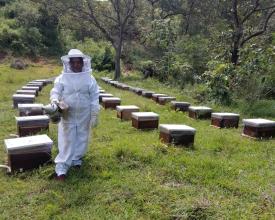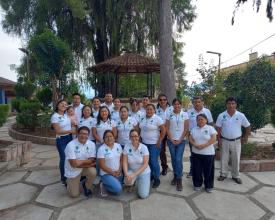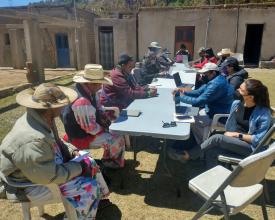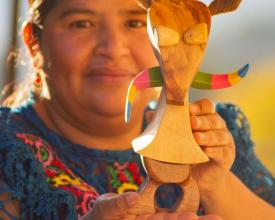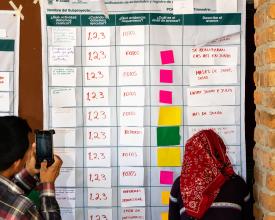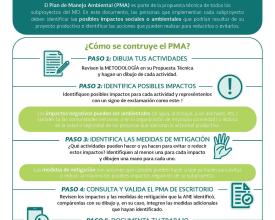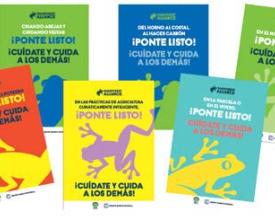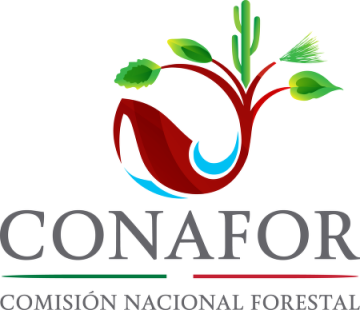Dedicated Facility Specifically for Indigenous Peoples and Local Communities (MDE Mexico)
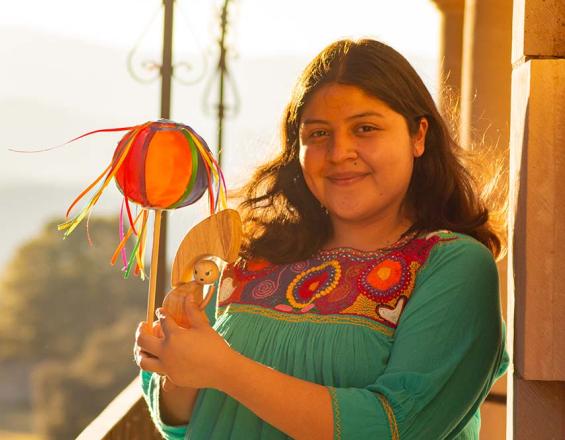
The objective of MDE Mexico was to strengthen the capacities of communities that live and depend on forests and jungles. Through participatory and inclusive processes for the consolidation of projects, MDE Mexico succeeded in rescuing the knowledge and know-how of the beneficiaries and strengthening their capacities to promote initiatives at the local level that contributed to combating the causes and consequences of the degradation and deforestation of natural ecosystems. MDE Mexico contributed to the technical, financial, administrative and organizational strengthening of 88 working groups (3,850 people) in an area of 120,792 ha in southeastern Mexico. The initiative was implemented through the Financial Inclusion Window, aimed at legally constituted groups with experience in implementing productive projects, and the Social Inclusion Window, aimed at women's and youth groups that were not legally constituted and had no experience in implementing productive projects.
Context
Challenges addressed
Deforestation and environmental degradation: Mexico is among the 10 countries with the highest deforestation, which is especially high in Quintana Roo, Oaxaca, Campeche, Yucatan and Jalisco. The causes are complex and a range of interventions are required to reduce emissions and to make forests economically viable for communities.
Poverty: In 2014, more than 40% of the poor were concentrated in 5 states, including Chiapas and Oaxaca, with the highest poverty rates among indigenous peoples. It is estimated that of the 12 million people living in forest areas in Mexico, more than half live in poverty and 5 million are indigenous.
Social exclusion: Cultural aspects, lack of training, lack of experience, as well as technological and communication limitations represent a major obstacle for women, youth and local people to access sources of financing for productive projects, preventing their involvement in community economic life.
Location
Process
Summary of the process
Capacity Building for the Implementation of Sustainable Productive Projects in Forest Landscapes (Block 1) and Technical, Financial and Administrative Accompaniment (Block 2) were key elements indispensable for the successful operation of the MDE Mexico, through the implementation of the Gender and Social Inclusion Strategy to reduce the Gaps for the Financing of Community Productive Projects (Block 3), the implementation of the Social and Environmental Safeguards framework (Block 5) and the Participatory Monitoring and Evaluation for the Management of Community Productive Projects (Block 4), which helped improve management and contribute to the transparency of the initiatives supported by the MDE Mexico. and the Participatory Monitoring and Evaluation for the Management of Community Productive Projects (Block 4) that helped improve the management and contribute to the transparency of the initiatives supported by MDE Mexico.
On the other hand, the Participatory Monitoring and Evaluation System for the Management of Community Productive Projects (Block 4) contributed to compliance with the Social and Environmental Safeguards (Block 5), as it recorded progress in the implementation of the Environmental Management Programs, developed to avoid or mitigate possible negative social and environmental impacts associated with productive activity, and to operate the System for Attention to Requests for Information and Complaints.
Building Blocks
Capacity building for the implementation of sustainable productive projects in forest landscapes.
The objective of the MDE Mexico was to strengthen the capacities of Indigenous Peoples and Local Communities that depend on forests and jungles through participatory and inclusive processes for the consolidation of productive projects in forest landscapes. The training began to take shape as soon as the subprojects were selected by the Evaluation Committee, whose members received training to facilitate analysis and dialogue on the proposals received to guide the evaluation and selection process.
On the other hand, the Local Technical Assistance provided the beneficiaries with accompaniment and specialized advice for the participatory construction of the technical proposals and the planning and monitoring instruments, which ensured the development of capacities and the appropriation of the instruments in each Working Group.
In addition, in order to provide technical support to the beneficiaries in the execution, monitoring and evaluation of the subprojects, a training program for change agents (Local Community Promoters) was implemented for community productive projects with a REDD+ approach.
Likewise, Knowledge Exchange Workshops were implemented among beneficiaries to strengthen their capacities with the knowledge of other more experienced groups.
Enabling factors
- Training at all levels and on various topics (project evaluation, technical, financial, administrative and organizational support and strengthening).
- Development of training materials and didactic activities adapted to the local context.
- Use of remote tools to provide beneficiaries with distance training in the context of the pandemic for groups with little or no previous experience in planning and monitoring activities for productive projects.
- Involvement of producers in training delivery.
Lesson learned
- The design of specific materials to guide producers facilitated the standardization of knowledge and coordination among actors.
- The appropriation of productive initiatives was favored by participatory processes, supported by culturally appropriate methodologies, materials and didactic resources.
- The use of digital platforms favored the dynamics of coordination and capacity building of Local Community Promoters (LCPs) and producers, particularly during the confinement imposed by COVID-19. The online modules and didactic resources allowed for self-directed learning.
- The PCLs' trajectory in MDE Mexico contributed to their personal growth and professional development, which is reflected in their initiatives and recognitions obtained, related to sustainable rural development, research and governance.
- The exchange of knowledge among communities promoted the creation of synergies among beneficiaries and the adoption of better production and governance practices in models that are in the early stages of consolidation.
Technical, financial and administrative support
In order for the producers to successfully implement their projects, various regional figures were called upon to provide them with the necessary support and accompaniment. The Local Technical Assistance teams, Local Community Promoters and Regional Operational Liaisons provided the groups with technical support to develop their proposals, collect evidence of implementation and prepare subproject reports. In the area of procurement, contracting and finance, the Regional Administrative Liaisons provided support and advice for the completion of procurement, contracting and verification procedures, through financial reports. For groups that were not legally constituted, the National Executing Agency (Rainforest Alliance Mexico) was in charge of administration, direct preparation of all procurement procedures, execution of allocated resources and the corresponding verifications. This shared responsibility with the beneficiaries made it possible to reduce the gap that exists for the groups and to fully comply with the highest standards in the execution of procurement, contracting and financial management during the implementation of the subprojects.
Enabling factors
- Creation of regional figures for permanent technical and financial support/advice.
- Designation of a focal point within the working group to promote good communication.
- Establishment of rules, procedures, methods, guidelines and standard documents for project execution in the Project Operating Manual.
- Providing technical, administrative and financial training to the working groups.
Lesson learned
- The designation of young people from ejidos or communities in the MDE Mexico intervention regions as Local Community Promoters facilitated the accompaniment and communication with subproject beneficiaries at the local level, particularly in those cases in which they acted as interlocutors or interpreters, facilitating the obtaining of key information in indigenous languages.
- Financial support to working groups with no legal status and little experience in managing productive projects required the design of specific collaboration schemes to ensure adequate technical and administrative support.
- The strengthening of administrative and financial management skills increased the beneficiaries' possibilities of accessing new sources of financing and investment in productive community projects.
Gender and social inclusion strategy to reduce gaps in financing community productive projects
In Mexico, there are barriers that hinder access to sources of financing for productive projects led by women and young people in the rural context, particularly those associated with land tenure and access to positions of participation, community and technical leadership. In addition, lack of access to training opportunities, limited experience, as well as technological and communication limitations, represent a major obstacle for these groups, not to mention the cultural aspects that are often incompatible with their involvement in community economic life. In this context, MDE Mexico addressed the social inclusion approach in a cross-cutting manner, through actions that favored the participation of women, youth and people without recognized agrarian rights or residents. The design of the Social Inclusion Window (VIS) made it possible to define specific financing strategies to facilitate the participation of these people and their inclusion in community development. These strategies resulted in an increase in the participation of women and young people in the identification and implementation of productive activities in forest territories.
Enabling factors
- Design of a call for proposals aimed at women and young people in rural areas with broadcasting on community radio stations to reach remote communities.
- Technical support to inexperienced groups for the construction of proposals and during implementation.
- Participatory construction of proposals for the appropriation of the projects from the beginning.
- Implementation of affirmative actions to favor the participation of women in activities and training.
- Agreement of local authorities for the execution of the productive activity.
Lesson learned
- The design of a support mechanism aimed at women, young people and residents made it possible to develop specific strategies for disseminating the call for proposals, technical support and capacity building. This prevented the traditional requirements for accessing financing opportunities from being a constraint for the working groups.
- The division of the VIS call for proposals into two stages facilitated the participation of groups with no experience in implementing productive projects, allowing the participatory construction of a solid technical proposal, based on an initial idea, and the appropriation of the projects from the beginning.
- The participatory construction of technical proposals gave a voice to women who had not participated in similar processes, which increased their leadership and facilitated their influence in decision-making spaces.
- Community validation for the development of the productive activity favored the generation of agreements in the community to ensure the viability of the VIS productive projects.
Participatory monitoring and evaluation for the management of community production projects
MDE Mexico designed a Monitoring and Evaluation System to measure its performance at different levels, which allowed reporting its results and lessons learned. This system was based on documentary evidence of the activities carried out during the implementation of the initiative, as well as on the information reported by project beneficiaries and the operation of the Information and Complaint Request System, linked to compliance with the project's safeguards. In this sense, the creation of mechanisms and tools to obtain first-hand information from the beneficiaries, under participatory and inclusive processes, was fundamental for its operation, for which the Subproject Monitoring and Participatory Evaluation System (SiMyEPS) was designed and implemented. This system brought together a set of principles, processes and participatory tools, so that the beneficiary groups themselves could measure their performance by monitoring, analyzing and reporting progress in the fulfillment of their activities and results. By documenting in this way the fulfillment of activities and objectives, the beneficiaries obtained relevant information to strengthen decision-making in their productive projects, improve their management and contribute to transparency.
Enabling factors
- Design of a Monitoring and Evaluation System to measure performance at different levels, which allowed reporting results and lessons learned to the different levels of project governance.
- Capacity building for system implementation, technical support, follow-up and training for beneficiaries (user manual).
- Ongoing accompaniment and advice to the working groups to support monitoring tasks.
- Information reported by project beneficiaries.
- Designation of a monitoring focal point within each group, whose responsibility was to coordinate monitoring activities within their organization.
- The strengthening of coordination mechanisms between facilitators to provide advice and follow-up in the field was key to simplifying the process of integrating technical reports, ensuring the quality of information and integrating evidence.
- Development of an adaptation strategy for implementing SiMyEPS remotely and under the implementation conditions of the groups.
- Generation of resources and didactic materials for the development of training activities, as well as the execution of participatory monitoring activities with a culturally appropriate language.
- Design of dynamics to facilitate the development of the implementation stages of participatory monitoring by facilitators and group members.
- Coordination between facilitators at the local level and the Monitoring Focal Point to ensure the correct implementation of the SiMyEPS, which facilitated the integration of technical reports and the systematization of evidence, which is the base information that feeds the result indicators of the MDE Mexico project.
- Design of a mechanism to facilitate the process of participatory construction of technical proposals remotely to prevent the COVID-19 pandemic from limiting capacity building and to encourage the adoption and implementation of participatory monitoring by the beneficiaries of the Social Inclusion Window. These mechanisms included the adaptation of instruments to record progress in the completion of activities and the design of didactic resources for remote capacity building (explanatory guides, instructions and video tutorials).
Lesson learned
- Participatory monitoring requires the adoption of tools to document and report on the fulfillment of activities and results in the implementation of a productive activity by local communities, using concrete evidence to contribute to the transparency and accountability of the financed projects.
- Documenting the fulfillment of activities and objectives provides relevant information to strengthen decision-making in productive projects and improve their management and performance.
- The development and strengthening of capacities for the participatory monitoring and evaluation of productive projects provides beneficiaries with the knowledge and tools for monitoring and reporting progress, as well as the achievement of goals, which will make it easier for them to carry out this activity in future projects financed by national or international donors.
- The continuous improvement and adaptations of the participatory monitoring system facilitated the adequate design of processes and tools based on the needs of the beneficiaries, achieving a better adoption of monitoring activities from their own experience.
- Technological and digital tools were innovative for documenting and evidencing progress remotely in pandemic contexts; however, direct follow-up and attention in the field was key to reinforcing beneficiaries' trust in the project and addressing specific challenges by improving the understanding and adoption of processes and tools.
Social and environmental safeguards
A reference framework for the implementation of Social and Environmental Safeguards was implemented, based on the World Bank's operational policies, as well as on the national and international legal and regulatory framework on safeguards. Safeguards are defined as those actions taken to ensure that the environmental and social impacts derived from productive activities can be identified and mitigated through the implementation of good practices. These were designed as a risk mitigation management system, but also to increase the positive impacts of the subprojects implemented. The development of a framework for the implementation of the Safeguards component ensured that this component operated transversally in all actions and stages of the project. This promoted the implementation of specific strategies and actions at the subproject implementer level, under the principles and standards established for achieving social and environmental objectives. As part of the implementation of safeguards for the MDE Mexico Project, Environmental Management Plans (EMP) were designed to identify the mitigation measures that each subproject had to implement to avoid or mitigate possible negative social and environmental impacts associated with its productive activity, thereby enhancing the benefits of each initiative. Its construction was carried out in a participatory manner, together with the selected beneficiaries, as part of the process for the integration of technical proposals and planning documents for each subproject.
Enabling factors
- Construction of EMPs to ensure compliance with the regulations applicable to each of the productive activities supported and to encourage the adoption of good social and environmental practices.
- Construction of a tool for the automatic generation of a desktop PMA and piloting: consultation process, feedback and validation of the instrument (participatory construction of the tool and appropriation of beneficiaries).
- Integration of mitigation measures (established in the EMPs) into the Annual Operational Programs to ensure their integration into the activities implemented.
- Mainstreaming of safeguards at different stages of the project.
- Design of an exclusive support window to facilitate the participation of women, young people and people without agrarian rights recognized in the call for proposals (Social Inclusion Window), in which the processes and requirements for submitting applications were simplified and a differentiated dissemination was made for women and young people, facilitating their access and increasing their participation.
- During the beneficiary evaluation and selection process, environmental and social criteria were included to ensure compliance with the legal framework applicable to each productive activity, as well as to encourage the implementation of good practices.
- Design of brochures on safe practices to strengthen the culture of occupational risk prevention within the subprojects.
- Creation of a mechanism for receiving and attending to requests for information and complaints to ensure that all requests for information and complaints related to the MDE Mexico and its implementation were registered and attended to in a timely manner (telephone number, e-mail, request or complaint form, information request form, etc.).
Lesson learned
- The generation of a reference framework for the implementation of safeguards in the MDE Project ensured compliance with environmental and social regulations, as well as the mitigation of potential impacts that could result from the implementation of productive activities supported by the MDE at different levels. It also ensured the mainstreaming of actions at different levels of project implementation and beneficiaries.
- The creation of an automated tool for the preparation of the EMPs streamlined the process for their participatory construction and improvement, within the framework of each subproject.
- The process of participatory construction of the EMPs allowed the subproject implementers to identify the potential risks and impacts of their productive activities and ensured the appropriation of a planning instrument that ensured the application of good social and environmental practices, maximizing the benefits of each subproject.
- The mainstreaming of safeguards in all components and activities of the MDE Mexico Project implied the development of specific strategies and actions both at the Project and subproject levels under the principles, norms and procedures established for the achievement of social and environmental objectives.
- Affirmative actions facilitated the participation of working groups made up of women and young people.
- Linking the PMA instrument with the subproject monitoring system facilitated follow-up, evaluation and reporting on compliance with mitigation measures by the implementers and made it easier for the National Executing Agency (Rainforest Alliance Mexico) to review, validate and record compliance with safeguards at the project level.
Impacts
We benefited 3,850 people (88 productive projects), who achieved an average annual income from the sale of their products of approximately USD$3.7 million. We also strengthened the capacities of beneficiaries to improve production practices in more than 120,792 ha and trained 26 young Local Community Promoters (65% women). As new agents of change, they developed skills to facilitate participatory processes for the accompaniment of community production projects. In order to share the different experiences of producers, 30 Knowledge Exchange Workshops were held on technical, business, organizational, governance, social inclusion, forest management and ecotourism topics. These workshops strengthened the capacities of 587 beneficiaries (34 localities), 76% of whom belong to an indigenous community. As a result, more than 90% of the beneficiary groups recognized that they had increased their capacity to reduce emissions from deforestation and degradation. The active participation of 33% of women and 25% of young people helped to trigger improvement processes for the consolidation of productive projects in the intervention area. With the W+ standard, it was determined that three groups of women in Oaxaca increased their income 74%, their knowledge/education skills 161% and their leadership skills 59.4%.
Beneficiaries
We benefited 3,850 people in Campeche, Yucatán, Quintana Roo, Oaxaca and Jalisco through 88 productive projects (agroforestry systems, silvopastoral systems, ecotourism, sustainable forest management and climate-smart agriculture).
Sustainable Development Goals
Story
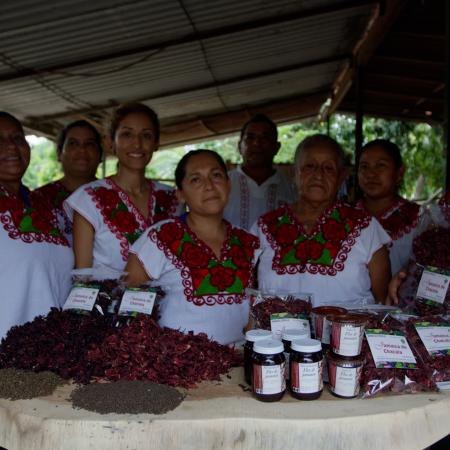
The community of Chacala is located on the southern coast of Jalisco. Its inhabitants mainly grow corn; however, for more than 50 years, hibiscus production has been introduced as an alternative income for families (about 30 ha of hibiscus are currently grown in Chacala). Until a few years ago, this crop was not profitable because the community did not have the processing or the necessary inputs to bag and label the product, so they were forced to sell their harvest to intermediaries, who would charge a very low price and resell it in other states.
In order to increase the market price of hibiscus, favor the economic improvement of the community and detonate a better quality of life for the families, MDE Mexico provided support to the Jamaica de Chacala group to produce in spaces that were only used to grow corn, and thus diversify the crops. The group used native hibiscus seeds adapted to the local soil and climate to avoid using toxic agrochemicals. They also took advantage of plots where they were already growing other crops to avoid deforestation, because they did not have to change land use to grow crops. In addition, it stopped burning to clear the land and used the weeds as natural fertilizer, thus avoiding the release of greenhouse gases. The crop rotation between corn and hibiscus also made it possible to control soil pests naturally, since corn pests do not proliferate as easily with hibiscus.
After harvesting the hibiscus, the group began to package and label the product to sell it directly to customers at a fair price in markets in Colima and Jalisco, making Jamaica de Chacala known.
The increase in sales, the process of diversification of products derived from hibiscus, such as jams, sauces and flowers, as well as the elimination of intermediaries, had a positive impact on the Jamaica de Chacala group and the community, as the producers began to feel more self-confident and to generate income to improve their quality of life and that of their families. The group began to be recognized in other municipalities and states for its work in agriculture and hibiscus production. The group is currently in the process of becoming legally constituted and consolidating its marketing strategy, in addition to having managed to increase its hibiscus production and sales price.


